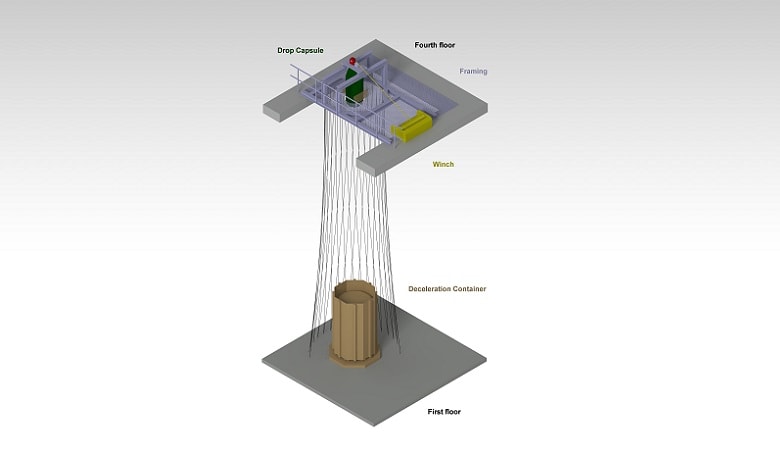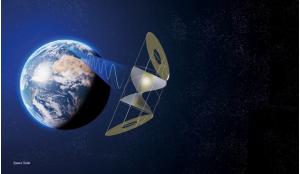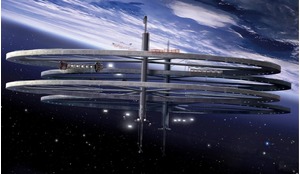All space missions begin on the ground of our home planet - so far. This will probably not change until humanity will reach a truly spacefaring state and we see experiments, payloads, satellites, probes, spacecraft and spaceships being developed, assembled, and tested completely in and finally launched from space. Until then we have to confront the challenges of simulating the various parameters of the (often harsh) space environment on Earth - accompanied by all the limitations we face when doing so. Microgravity is one of the more difficult environmental parameters to simulate.
What to do with Microgravity?
Since the beginning of human space exploration in the middle of the 20th century, when astronauts conducted first medical and biological experiments on board of spacecraft and later space stations, microgravity became increasingly important for many areas of research. Many phenomena can only be studied in a microgravity environment, where acceleration due to gravity cannot be felt. Especially for many areas in the space sciences microgravity is essential, since material behavior, fluid dynamics as well as combustion processes show an altered behavior. Before launching spacecraft into space, it is also very important to study and test the effects of microgravity onto components and processes on Earth - increasing resource and cost efficiency.
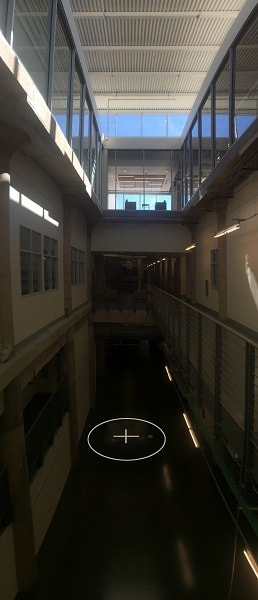 Hallway and atrium of the BRIC where the drop tower will be located
Hallway and atrium of the BRIC where the drop tower will be located
One might be surprised but microgravity is not limited to the above mentioned topics, indeed there are many other fields of research such as biology, medicine as well as fundamental physics conducting experiments in microgravity. In example new insights about crystal formation were gained, which can be applied to the development of innovative medication or microchip manufacturing improvements.
Where can I get some Microgravity?
Besides the already mentioned spacecraft, there are several other facilities which can be used to conduct microgravity experiments. The best-known are probably parabolic flights used for astronaut training or hardware development and qualification. They allow experiment times of a few tens of seconds, however the quality of microgravity is often lower in comparison to other experiment facilities. Sounding rockets offer higher quality levels as well as increased experiment times of up to several minutes. Since they are launched to altitudes of 80 kilometers and more, however the cost and effort for preparation work and launch are relatively high.
Drop tower facilities are able to offer a good quality of microgravity combined with adequate payload masses and the advantage of virtually unlimited repeatability under same experiment conditions, at a low cost but limited in duration of microgravity conditions by the available height - often to a few seconds. The basic principle is to simply drop the experiment from a great height, thus getting accelerated by Earth’s gravity. During freefall the experiment does not experience any weight force, only air drag needs to be reduced in order to gain a good quality of microgravity. This can be achieved in two ways: either the drop capsule falls entirely in an evacuated drop shaft or the experiment falls inside a drag shield under normal atmospheric pressure.
A Drop Tower in Central Texas!
Around the globe there are only about one and a half dozen operational drop towers being used for microgravity research and testing. Many are built and operated by universities with scientific demand for such experiments and some are also used by industry and space agencies.
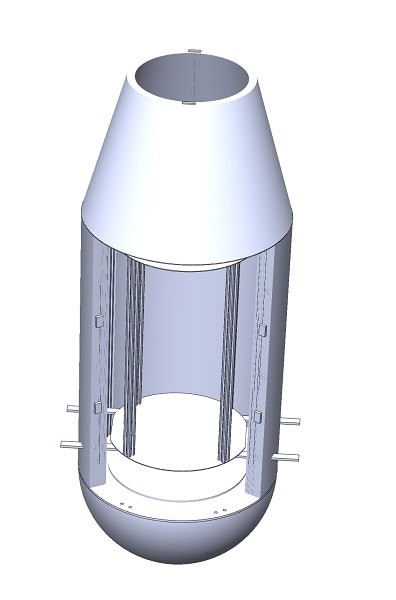 Drop capsule with inner capsule inside of drag shield; battery and electronics inside nose cone
Drop capsule with inner capsule inside of drag shield; battery and electronics inside nose cone
The original idea for a low-cost high-quality drop tower was already under development by two of the co-authors back in 2008 in Stuttgart. The collaboration between the Center for Astrophysics, Space Physics, and Engineering Research (CASPER) at Baylor University, Texas, and the Institute of Space Systems (IRS) at the University of Stuttgart, Germany, provided an opportunity for such a project within Baylor University's then planned new research facility, which would become the Baylor Research and Innovation Collaborative (BRIC).
The BRIC facility, which in its former days used to be a tire factory, was recently transformed into a modern research building by Baylor University and stakeholders like local communities and academia as well as private foundations. The idea of this research center is to expand the research environment for Baylor University beyond the university campus as well as to promote scientific cooperation between researchers and local industry. Since the drop tower shall be used for in-house experiments by Baylor University students and faculty as well as by external research institutions and industrial partners it fits perfectly into the concept of the BRIC.
The location in Waco, a booming city in Central Texas, is quite attractive due to its close vicinity and highway connection to the metropolitan areas of Dallas/Fort Worth, Austin, San Antonio and Houston, which are accommodating a variety of universities and research institutions with scientific and engineering background as well as a large number of companies operating in the field of aerospace and space sciences. Many are located in less than three hours driving distance. In the regional context the Baylor University drop tower would be the only facility providing a high quality microgravity environment in the 1.5 to 2 seconds range within about three hours of flight time.
The concept of the Baylor University drop tower is to combine several aspects: high quality microgravity experiments opportunities for scientific and industrial customers as well as education and outreach purposes. Implemented by applying a low-cost and commercial-off-the-shelf approach in design and development taking advantage of existing in-house facilities and laboratory equipment.
The drop tower itself will be integrated into one of the center hallways of the Baylor Research and Innovation Collaborative (BRIC) building. The facility will extend over four floors, with a height of over 17 meters in order to use the maximum available height for dropping the capsules. Since the hallway is an open space inside the building and clearly visible for everyone walking by, special efforts have been undertaken to create a visually attractive design. It consists of a wire rope structure in the shape of an hourglass surrounding the capsule’s drop corridor, which combines an esthetic look with operational safety as well as functionality. The inspiration for such design is clearly taken from ESA-ESTEC's drop tower demonstrator at the Erasmus User Center in Noordwijk, The Netherlands.
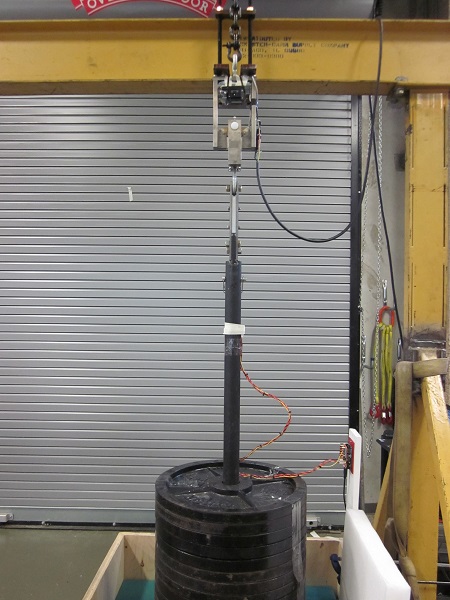 Test setup for molten rod release mechanism (with up to 30 x 20 kg stacked weight plates from athletics department)
Test setup for molten rod release mechanism (with up to 30 x 20 kg stacked weight plates from athletics department)
Of course, besides the outer appearance, the performance of the drop tower such as the experiment duration and the level of quality of microgravity are substantial. The aim is to achieve experiment durations of at least 1.5 seconds with a quality of microgravity of better than without using a low atmospheric pressure environment. Drop towers using an evacuated drop shaft are able to offer quality levels of up to because dropping the experiment in near-vacuum prevents it from residual forces caused by air drag. However, such a design increases the complexity and hence leads to higher investments and operating cost.
Since a low-cost design approach was chosen for the Baylor University drop tower another proven and commonly used design philosophy was chosen: a dual capsule system. It enables conducting experiments without the need for an evacuated drop shaft while still providing high quality levels of microgravity. The basic principle is to drop the experiment capsule inside a drag shield, which protects the experiment from disturbing forces induced by surrounding airflow. This is a proven design used at other drop tower facilities around the globe with drop durations of up to 2.5 seconds, while still offering quality levels of microgravity of better than . Simulations of aerodynamically optimized drop capsules of the planned Baylor University drop tower even showed an increase in quality by one order of magnitude. Another benefit of this design is a fast turnaround because there are no time efforts for the evacuation process enabling a larger number of experiment runs per day.
The microgravity experiment will be installed into the inner capsule which has a diameter of 0.6 meters and a height of 0.95 meters in order to provide sufficient volume to carry standard sub racks of the International Payload Rack used on the International Space Station as well as common sounding rocket payload envelopes without modification. Preparation and installation of the experiment, weighing up to 160 kilograms, is going to take place in a separated preparation area. There, users have the possibility to conduct experiment assembly, functional tests as well as post-drop documentation procedures in a closed environment. Furthermore, the area is used to integrate the inner capsule containing the experiment into the aerodynamically shaped drag shield. From the moment of integration, which is finalized by closing the cylindrical and air-tight side walls of the drag shield, until the experiment run is completed all systems onboard require power supply. This is provided by an onboard battery system located in the drag shield nose cone next to the capsule sensor and diagnostics electronics.
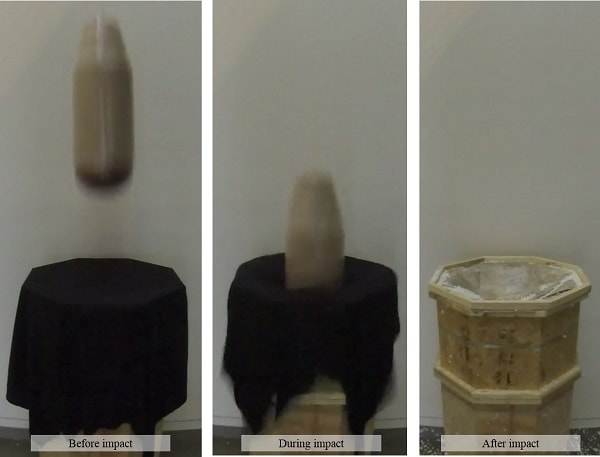 Deceleration test device at 40 percent scale from approximately 12 meters height
Deceleration test device at 40 percent scale from approximately 12 meters height
After the experiment is prepared and integrated into the drag shield, it is ready for the “roll-out”. The drop capsule system gets transported to the bottom of the drop shaft where it gets attached to the release mechanism, which itself is permanently connected to a winch near the top of the facility. Special considerations were made for the design of the release mechanism, to reduce disturbing vibrations caused by every release decreasing the quality of microgravity during the initial drop sequence. This is why a new release mechanism was designed: the molten rod release. It enables a smooth sequence by simply melting a plastic rod holding the entire capsule weight. The release itself will be triggered remotely from a drop tower control room sometime after the capsule is lifted up to the top of the drop shaft. While the capsule is lifted up, a deceleration container gets moved at the bottom of the drop shaft. After release, the inner capsule falls freely inside the drag shield until they both enter the deceleration device where the kinetic energy gets dissipated. A soft deceleration shall be achieved by using either an airbag system or small polystyrene beads depending on the requirements of the experiment.
How to get the job done!
The overall design and development was done mainly with large involvement of several exchange students from Germany as well as a few Baylor undergraduate team project students and interns. The German students from various universities performed each a drop tower related thesis at CASPER during individual stays of four to eight months within the international collaborations over a time frame of now over three years. Therefore, special thanks go to funding partners, supporting institutions and supervising faculty and research staff members on both sides of the Atlantic Ocean.
The next step in this fascinating endeavor will be the implementation of all the design and development efforts: building the drop tower! With significant private foundation grant funding already awarded and serious local civil engineering and construction planning under way that will hopefully be achieved very soon.





